How much electricity does a refrigerator consume? We figure out how to choose economical equipment
The refrigeration unit occupies perhaps the most honorable place in any kitchen. Without it, it is impossible to store food and prepared dishes for a long time.During continuous operation, equipment constantly wastes energy. The power consumption of the refrigerator will tell us about its consumption. Agree: this is one of the important selection criteria.
We will tell you how to find an economical model and what characteristics you should pay attention to. Our proposed article provides selection rules and lists external factors affecting energy consumption. To make your search easier, we present a rating of models with the “least appetite.”
The content of the article:
Main energy consumption classes
Back in the 90s, all modern household appliances began to be divided according to the newly introduced energy consumption classification. This equally applies to both miniature light sources and large water heating tanks and washing units.
Now labeling indicating the class inherent in a particular device is mandatory.
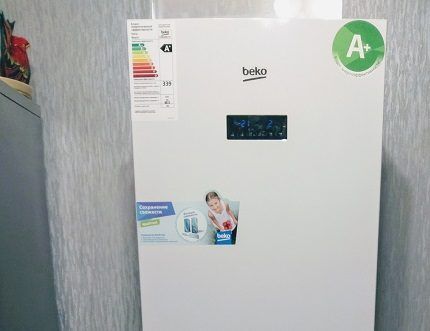
On average, annual electricity consumption in kilowatt-hours is in the range of 235-465 kW. Knowing the parameter, calculating the approximate daily or monthly figures is not difficult.
To do this, it is enough to divide the declared value by the number of days/months in a year - 365/12. For example, if a device consumes 230 kW/h annually, then the daily rate is approximately 0.63 kW/h. Monthly calculations are carried out using a similar principle.
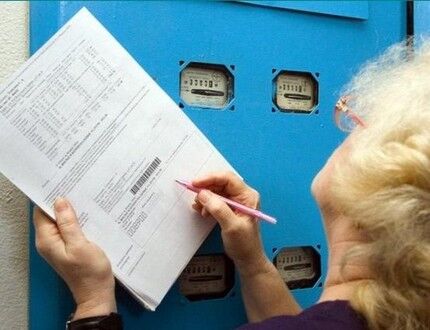
Consumption classes are designated in Latin letters ranging from A before G. Each of them is assigned a color graphic indicator for a more understandable perception. Some designations are supplemented with an index «+».
The gradation is determined by dividing the actual amount of consumption by the standard indicator. The first figure is established during experiments.
The second is obtained as a result of calculations using a complex formula, which involves many components - volumes of departments, temperature, technologies used, climate class, etc. Information is provided to the user in the form of a percentage of energy consumed for a specific time period to specified standards.
The ABC of energy consumption of refrigerators looks like this:
- A+++ – up to 22%;
- A++ – 22-33%;
- A+ – 33-42%;
- A – 42-55%;
- B – 55-75%;
- C – 75-95%.
The most economical and rational technology is considered to be in the category A with a green indicator of different shades, the most expensive - G, marked in red. Aggregates A+, A++, A+++ consume three times less than generally accepted standards.
Devices below class WITH They are practically no longer produced, as they are malicious wasters of light. Energy consumption of such refrigerators from 110 to 150%. These values are far from the norm and can cost a pretty penny.
The average option in terms of energy consumption includes equipment marked B And C. It saves approximately 15 to 35% of resources.

The difference between refrigerators classified into different classification categories can be quite significant. Unit type A++ only 143 kW/h is needed per year, while its brother G consumes more than 900 kW/h over the same period.
Models can help you save your family budget A+++, which are 50% more economical than even equipment that has a class A+. It is quite natural that they cost an order of magnitude higher, but the subsequent savings will soon pay for the investment in the purchase with interest.
Rules for choosing an economical refrigerator
Despite all the markings and miscalculations, the fact that how much electricity the purchased refrigerator will consume is influenced by a lot of circumstances.
Some of them are hidden in the design and configuration, others depend directly on the user and on how favorable conditions he creates for the operation of the equipment.
The number of kilowatts consumed by a refrigerator per day, month or year is not calculated based solely on data from the technical passport. The parameters are also influenced by the filling that the manufacturer supplies its development with.
If you want to find the most economical device, you should first consider the following nuances:
- number and type of compressors;
- cooling system;
- chamber volume;
- tightness and thermal insulation;
- set of functionality.
Compressor. The range includes one- and two-compressor models of refrigeration units.
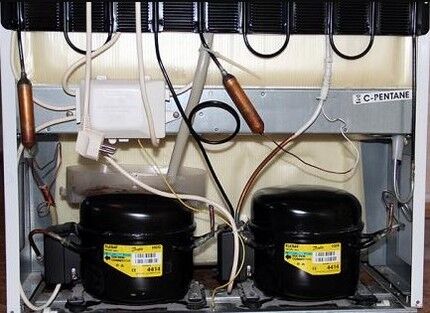
As a rule, versions with two motors are more convenient to use, since they provide more options for effective temperature control and defrosting.
When choosing equipment, you need to pay attention not only to the number, but also to the type of compressors. In terms of energy consumption, they win by a significant margin inverter models. The operating mode of the inverter is different in that it instantly raises the temperature to the set values and constantly maintains it, smoothly changing the power.
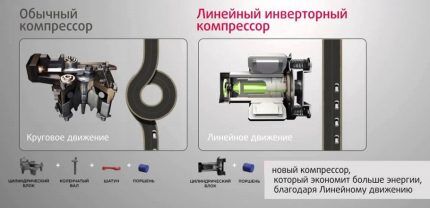
A conventional compressor takes longer to reach the required levels, turns on at full power, and then turns off. As soon as the sensor detects temperature changes, thermostat starts the mechanism again. This adjustment technique is called stepwise. In terms of saving electricity, it is imperfect.
Cooling system. Modern refrigeration units are equipped with two main cooling systems - drip or NoFrost. In devices with a drip system, the evaporator, which maintains a cold temperature, is located on the rear wall. Over time, the formed pieces of ice flow down in drops into the pan, where they evaporate.
Innovative technology NoFrost involves dry freezing, in which frost does not appear and ice does not freeze. The evaporator is built above the freezer compartment or behind the back of the unit.Products are frozen by blowing cold air, which is provided by fans.
Once every few hours the fan stops, at this time the heating component is turned on, the melted liquid is transferred through special grooves into the pan and evaporates. Such refrigerators do not require defrosting.
System "no frost" includes several subspecies - Full No Frost, Total No Frost. There is also combined cooling, combining two main types. In terms of energy consumption, the traditional cooling system is more economical.
Due to the presence of additional fans and a powerful heater, NoFrost technology is more demanding on energy resources.
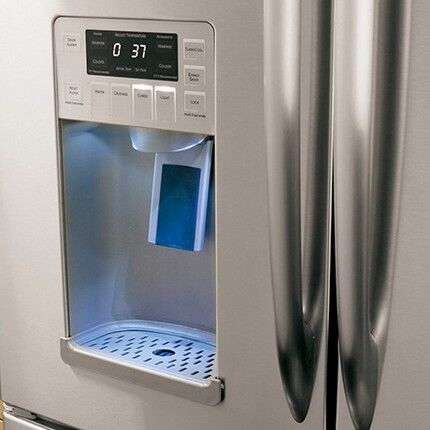
Number and size of cameras. As for the number of compartments, the best option for the consumer is two-chamber models. Single-chamber counterparts are not so “gluttonous”, but they are usually installed only in those rooms where space does not allow them to accommodate impressive dimensions.
The energy consumption index is also affected by the volume of refrigeration equipment: the larger it is, the more noticeable the consumption.
Tightness. Before buying a refrigerator, you need to check the quality seals and thermal insulation configurations of the body. Their lack of reliability is dangerous due to excessive loss of cooled air, which provokes an increased load on the compressor and, accordingly, increases energy costs.
Even the color of the product is reflected in the kilowatts consumed.It has been established that silver material has lower emissivity and releases heat more slowly.
The influence of external factors on energy consumption
To achieve high-quality operation in the maximum possible economy mode, any refrigerator must provide the necessary conditions. Manufacturers indicate most of them in the instructions that come with the product.
In general, energy consumption will depend on:
- air temperature in the room where the device is installed;
- the degree of food load in the working chambers;
- door closing/opening frequencies;
- timely defrosting.
Ambient temperature – one of the leading criteria. In the process of research and scientific experiments, it has been proven that refrigerators operating in rooms where average readings of 16-17 degrees Celsius are recorded save the budget by approximately 1.5 times.
This does not mean that the equipment can be installed in critically cold environments. Under such conditions, the compressor simply will not turn on or, worse, will fail altogether.

Camera workload. Before filling the refrigerator with food, you should study the technical parameters and manufacturer’s recommendations in this regard. You should never load it to capacity.
It is also worth distributing provisions evenly across shelves and departments, otherwise air circulation will be difficult, which is also not the least important for energy consumption.
Defrosting. If the refrigerator is not equipped with an automatic system, do not forget about regular self-defrosting.
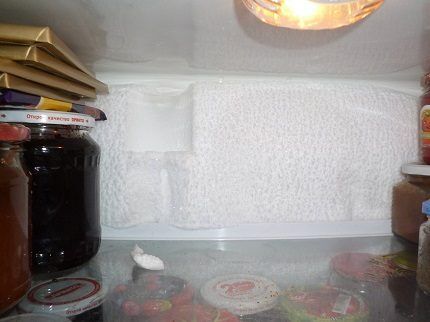
Exploitation. If the unit door is opened frequently, the load on the motor immediately increases. This is due to the fact that the cooled air accumulated inside quickly escapes outside. Accordingly, to make up for losses, the device begins to work at maximum power, increasing electricity costs.
TOP 5 economical refrigeration units
Having set the goal of purchasing the most economical model, you should study in more detail the offers of leading manufacturers. The range of refrigeration equipment is rich and choosing the best option that meets your needs is not difficult.
We invite you to familiarize yourself with 5 economical units from the best manufacturers.
Model #1 - Liebherr CBN 4815
The CBN 4815 unit of the Liebherr brand has a high price, averaging 72 thousand rubles, but also the most economical consumption category at the moment - A +++.
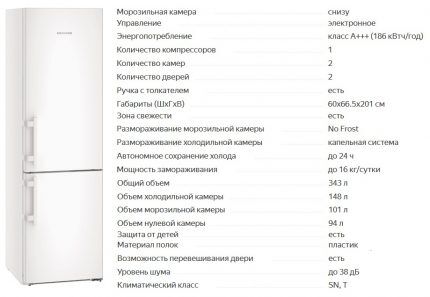
Despite such modest needs, the manufacturer managed to combine many innovative developments in the unit. It provides convenient flexible temperature settings using a touch screen, a super freezing option, and a built-in activated carbon filter that purifies the air from bacteria and contaminants.
The doors are protected with a reliable, replaceable seal that matches the color of the body. The only drawback of the modification stems precisely from the main advantage - efficiency.
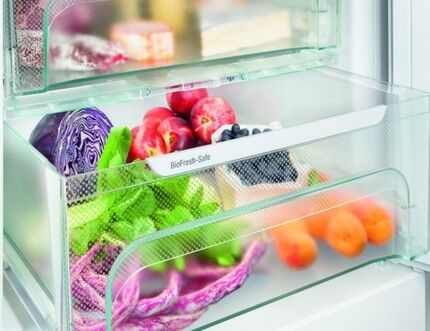
We are talking about the low power of the compressor, which takes a long time to produce cold when turned on. It takes about a day for it to enter normal operating mode, despite the fact that most modern and Soviet refrigerators reach the desired temperature within 10-30 minutes.
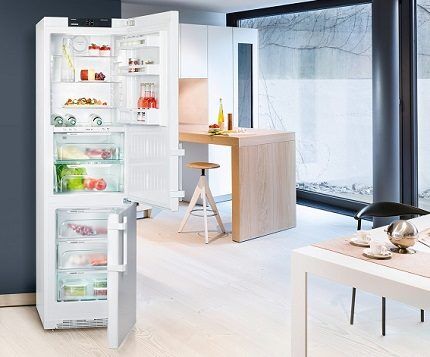
The following video demonstrating the main capabilities of the model and the layout of the internal space of the working chambers will help you form your opinion about the CBN 4815:
In the wide range of Liebherr products, in addition to the refrigerator we presented, there are a number of excellent models. They have earned the recognition of both owners and repairmen, who rarely have to restore their functionality. Compiled by us refrigerator rating will help you choose the best option.
Model #2 – LG GA B489 YEQZ
The spacious and tall GA B489 YEQZ equipment from the LG brand, A++ class equipment, is cheaper than the previous model. The cost of this model starts from 51 thousand rubles.
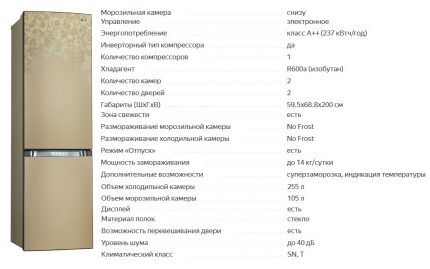
Energy consumption indicators are 237 kW/h per year, 20 kW/h per month, 0.65 kW/h per day. The unit operates on an economical and relatively quiet inverter compressor. It comes with a ten-year warranty period.
No Frost applies to both compartments, so the freezer compartment does not need to be defrosted manually. Each compartment has LED lighting.
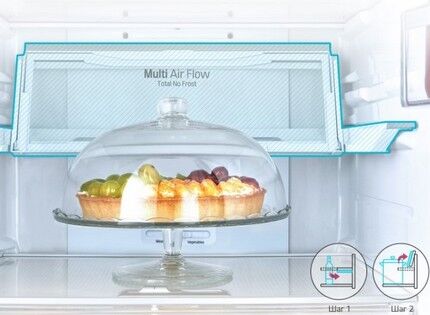
A special feature of the model is the unusual structure of the lid of the block for vegetables/fruits. It has cells that trap condensation, preventing drops from falling on the food.
Thus, the optimal humidity necessary to preserve the taste and beneficial properties is maintained.
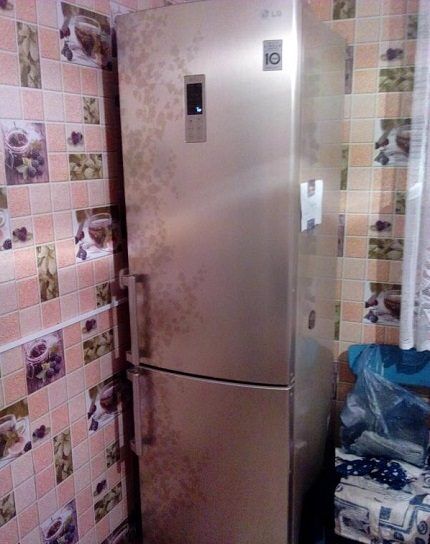
In addition to the model we have described, the assortment offered to the consumer also includes a number of interesting offers, with best LG refrigerators The article we recommend will familiarize you with it.
Model #3 - Bosch KIS87AF30
Built-in appliances made in Germany, distinguished by their interesting design and compact dimensions, are an ideal solution for cramped kitchen spaces.
The Bosch KIS87AF30 refrigerator is characterized by class A++, in which it consumes 226 kW/h per year, 19 kW/h per month, 0.62 kW/h per day. Its cost averages 49 thousand rubles.
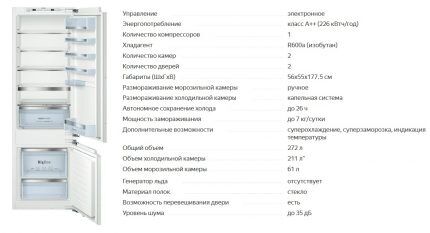
The equipment is controlled through an electronic sensor unit, which allows you to set a favorable temperature regime for both the refrigeration and freezer compartments.
The inner surface is treated with an antibacterial mixture that suppresses the spread of microorganisms and bacteria.
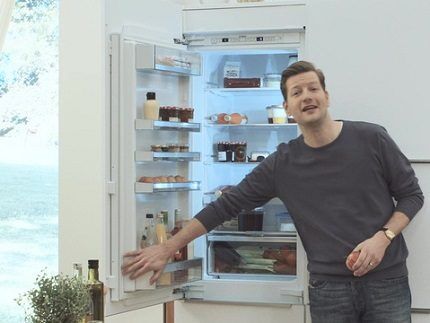
A line of popular German Bosch brand refrigerators The next article will present an analysis of their features and characteristics.
Model #4 – Samsung RB-31 FERNCSA
Model Samsung RB-31 FERNCSA with a set of good technical characteristics and an affordable price.
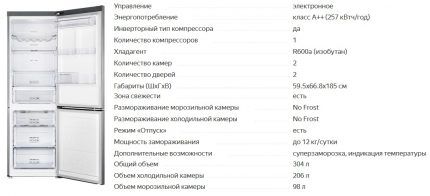
At the declared level, the parameters are in the mode "Vacation". Nevertheless, the unit is quite economical: 257 kW/h per year, 21.5 kW/h per month, 0.70 kW/h per day. The volume of the chambers in the refrigerator is quite large - 304 liters. Their interior space is well organized.
Design elements such as a tray for sauces, a convenient drawer in the freezer, and a shelf on wheels allow you to quickly remove the necessary products from the farthest corners of the chamber. There is a special compartment with a freshness zone for meat and vegetables.

The device has a built-in inverter motor that operates in five effective modes. It is silent, quite durable, and is not afraid of changes in the power supply.
The South Korean manufacturer supplies the market with excellent household appliances, including functional and reliable refrigerators, the characteristics of which we suggest familiarizing yourself with.
Model #5 - Siemens KG39NXB35
Stylish Siemens KG39NXB35 with thoughtful technical content and touch controls. Energy consumption class – A++. For full operation, it spends 273 kW/h per year, 23 kW/h per month, 0.74 kW/h per day.
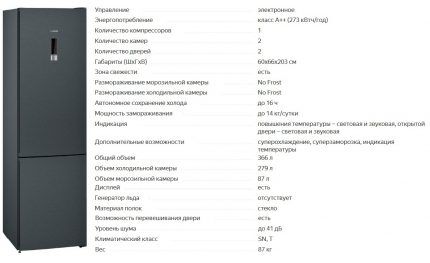
The useful volume of the equipment is impressive and amounts to as much as 366 liters. A freshness zone is built inside the refrigeration section, providing the necessary conditions for long-term storage of vegetables and fruits.
In addition to the standard adjustable tempered glass shelves, there is a chrome-plated metal bottle rack. The freezer compartment has a freezing calendar.
An expert video review will help you understand the model’s capabilities in more detail:
The best refrigeration machines from the famous German concern presented here: The rating is based on reviews from users and representatives of service workshops.
How to prevent overconsumption of electricity?
The actual energy consumption figures, for which you will have to pay on receipts, largely depend on the correct installation location and compliance with the normal operating conditions of the refrigerator.
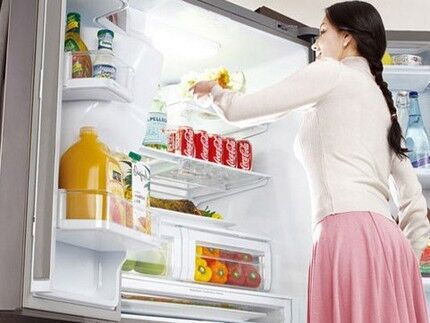
In order not to be upset because of too high amounts, you should find out in advance how to choose a refrigerator, and take note of some useful tips:
- Do not set the temperature in the freezer at the lower limit of the normal limit if you do not plan to store large volumes of food in the chamber for a long period.
- Adjust the thermostat taking into account the occupancy of the unit and the ambient temperature.
- Open the appliance doors only when absolutely necessary. Keep the equipment open for a minimum time, then close the door tightly.
- Before storing dishes and food in the refrigerator, cool them to room temperature.
When installing equipment indoors, you need to leave a gap between the back of the case and the wall. The minimum gap is 10 cm. The same applies to the sides. It is advisable that the device does not come into direct contact with nearby furniture and appliances.
There should be no heating equipment near the installation site of the device. It is necessary to try to protect it from close contact with radiators, stoves, ovens and other heat sources.
Conclusions and useful video on the topic
An experiment to measure the amount of energy consumed by a two-compressor refrigerator per day:
Economical life hack from one of the users:
Having set the goal of purchasing a refrigerator that will become an excellent assistant in everyday life and will not increase the total amount of monthly electricity bills to exorbitant figures, it is enough to take into account the given rules and tips.
When choosing an economical unit, it is wiser to choose a high-quality two-chamber class A model with an inverter motor and only those functions that are really necessary.
Please write comments, post photographs and ask questions about the topic of the article in the block below. Tell us about how you selected the refrigerator model, how much electricity is required to operate your refrigeration machine. It is possible that you have information that will be useful to site visitors.




Before purchasing, we always intuitively paid attention to the class of the refrigerator and always chose A+++ without even knowing what it meant. You cannot save on a refrigerator, since it is purchased for many years, and the quality of the products depends on it.For example, in our old refrigerator, perishable food was stored for only 3 days, but in the new Bosch it lasts up to 5 days and it consumes less electricity.
Well, after all, energy saving is far from the main criterion by which you should choose a refrigerator and household appliances in general. To be honest, I generally perceive all these A pluses more as an advertising ploy from brand companies. The size of the refrigerator, the number of chambers, the presence and location of the freezer, functionality, and most importantly, the price. All this is much more important.
Not the main one, but all other things being equal, why not take a refrigerator that “eats” little electricity? If you select energy-saving appliances for your home, the savings will be significant.